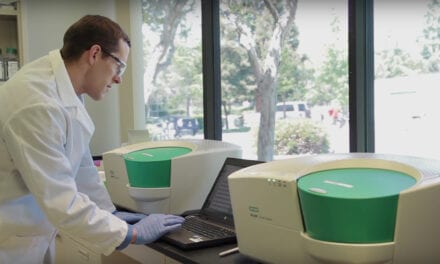With testing volumes going through the roof, automation is needed more than ever, particularly for small and mid-sized labs that are in underserved geographic areas. Automation will help labs of all sizes meet the demands related to ongoing COVID-19 testing.
by Jacqui Reithel, MBA
Clinical laboratories have played a critical role in response to the COVID-19 pandemic, drawing attention to the work laboratory professionals do as never before. In addition to fulfilling the current testing needs, laboratories have an unprecedented responsibility to prepare for the pandemic’s aftermath1.
The pandemic has also put enormous pressure on clinical laboratories — from increased testing volumes and turnaround time, to biosafety, workforce planning, and social distancing within the lab2. As of December 2020, across the industry total testing volumes were 245%of baseline3. Routine testing, which saw a drop of 66% in the early days of the pandemic, is now already over 100% of pre-pandemic baseline levels (in the U.S.), while COVID-19 and routine testing volume combined is just under 250% of baseline. Industry experts predict substantial COVID-19 testing throughout 2021 and even into 20224, and an increase in highly sensitive antibody testing as the number of people vaccinated rises5.
The Need for Small- and Mid-sized Laboratories
The problems, such as shortage of laboratory technologists and technicians6, historic financial pressures on hospitals and health systems7, and physically and mentally exhausted laboratory professionals8 — which existed before the pandemic — have only been exacerbated. The shortage of staff is considerable when you look at regional labs staffed with smaller teams. These labs have fewer resources than larger labs, but continue to test at two to three times their average volumes as they secure more local employer and provider COVID-19 testing contracts, while the larger labs often capture the major testing contracts for situations such as student body testing at higher education institutions9.
Automation for All?
Workflow automation, an important breakthrough in the recent history of laboratory diagnostics, integrates multiple diagnostic specialties to one single track to improve efficiency, organization, standardization, quality, and safety of laboratory testing10. The major economic revenue of workflow automation, resulting from merging many diagnostic platforms within a consolidated system, not only encompasses a reduction of manual workforce (especially auxiliary and technical staff) needed for managing high-volume testing, but is also attributable to lower pre-analytical and post-analytical expenditures11.
Automation plays a key role in addressing staff shortages while enabling precious resources to focus on high-value clinical tasks, particularly during the COVID-19 pandemic12. Even though molecular testing, which is the gold standard for diagnosing COVID-19, is not included in current workflow automation solutions, automating manual processes for routine tests free up lab resources to do more COVID-19 or other dedicated scientific work. In labs that process fewer than 5,000 tests a day, there are maybe one or two technicians on staff, making workflow automation even more vital.
While automation is a reality today for large laboratories, the available solutions are neither total or wholly automated for small- and medium-sized labs.
Not Just for Large Labs
COVID-19 has highlighted the need for small- and medium-sized labs to cater to populations that do not have easy or fast access to large laboratories. In the future, the drive to consolidate will have to be balanced against the need to have adequate geographic coverage for testing. This means that small- and medium-sized labs will continue to see a rise in test volumes without an increase in resources, making automation an attractive option. The lab automation that caters to labs processing high volumes of samples is out of reach for smaller-volume labs due to space requirements and infrastructure constraints.
The right fit for these labs is a solution that offers a comprehensive workflow automation that:
- Reduces manual steps through pre-analytical, analytical and post-analytical automation, conserving precious human resources to do higher-value clinical tasks while fitting within the space constraints.
- Adapts to meet a mid-volume lab’s space requirements and infrastructure needs with a flexible design.
- Dynamically calculates route scheduling for rapid and consistent turnaround time (TAT), with short turnaround times (STATs) always prioritized to deliver results faster with intelligent routing
Just because a lab is not processing a large number of samples shouldn’t mean it has to sacrifice the benefits of intelligent laboratory automation and settle for a marginally automated workcell plus solution. The market is ready for workflow automation that can help small and medium-sized labs meet the testing needs of their community.
About the Author
Jacqui L. Reithel is senior manager of WITS Process Consulting for Beckman Coulter Diagnostics. She is responsible for coordination of automation workflow, managing a team of 12 process consultants. Prior to joining Beckman Coulter, Reithel held various management positions in laboratory services. This is where her Six Sigma training and passion for improving workflow for laboratorians formed. Reithel joined Beckman Coulter Diagnostics in 2014 as a process consultant. In 2017, she was promoted to the manager role. Reithel received her MBA from Franklin University and completed her studies in lab science at Ferris State.
REFERENCES
1 Sahajpal, N. S., Njau, A., Mondal, A. K., Ananth, S., Chaubey, A., Rojiani, A., & Kolhe, R. (2020). Role of clinical laborato ries in response to the COVID-19 pandemic. Future medicinal chemistry, 12(17), 1521–1523. https://doi.org/10.4155/fmc-2020-0129
2 Fang, B., & Meng, Q. H. (2020). The laboratory’s role in combating COVID-19. Critical Reviews in Clinical Laboratory Sciences, 57(6), 400–414
3 The clinical lab in 2020: The impact of COVID-19 this year and beyond. (n.d.). Retrieved April 6, 2021, from 360Dx.com website: https://www.360dx.com/clinical-lab-management/clinical-lab-2020-impact-covid-19-year-and-beyond
4 Jude. (2020, October 26). Three prominent clinical laboratory leaders make the same prediction: COVID-19 testing will be significant through 2020 and throughout 2021. Retrieved April 6, 2021, from Darkdaily.com website: https://www.darkdaily.com/three-prominent-clinical-laboratory-leaders-make-the-same-pr ediction-covid-19-t esting-will-be- significant-through-2020-and-throughout-2021/
5 XIFIN. (2021, January 26). XIFIN innovation drives growth in four key business areas amid COVID-19 pandemic. Retrieved April 6, 2021, from Xifin.com website: https://www.xifin.com/news/press-releases/2021/xifin-innovation-drives-growth-four-key-business- areas-amid-covid-19
6 Ford BA & McElavania E. “Machine Learning Takes Laboratory Automation to the Next Level.” Journal of Clinical Microbiology. Mar 2020, 58 (4) e00012-20; DOI: 10.1128/JCM.00012-20
7 Hospitals and Health Systems Face Unprecedented Financial Pressures Due to COVID-19. May 2020. American Hospital Association. https://www.aha.org/guidesreports/2020-05-05-hospitals-and-health-systems-face-unpreced ented-financial-pressures- due [Accessed: March 1, 2021]
8 Medical laboratory professionals perform COVID-19 tests, face burnout and exhaustion. Ragas, Lindsey. Dec. 28, 2020. CBS Austin. https://cbsaustin.com/news/local/medical-laboratory-professionals-perform-covid-19-tests-face-burnout-and-exhaustion [Accessed: March 1, 2021]
9 XIFIN. (2020, September 22). XIFIN executives expect 15% increase in fall COVID-19 testing volumes; Seeing regional labs pick
up overflow from larger, national players. Retrieved April 6, 2021, from Xifin.com website: https://www.xifin.com/news/press – releases/2020/xifin-executives-expect-15-increase-fall-co vid-19-testing-volumes
10 Lippi, Giuseppe and Da Rin, Giorgio. “Advantages and limitations of total laboratory automation: a personal overview” Clinica l Chemistry and Laboratory Medicine (CCLM), vol. 57, no. 6, 2019, pp. 802-811. https://doi.org/10.1515/cclm-2018-1323
11 Archetti C, Montanelli A, Finazzi D, Caimi L, Garrafa E. Clinical laboratory automation: a case study. J Public Health Res 20 17;6:881
12 StackPath. (n.d.). Retrieved April 6, 2021, from Mlo-online.com website: https://www.mlo-online.com/continuing- education/article/21163060/the-benefits-of-lab-automation-to-facilitate-testing-for-sarscov2





